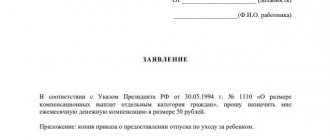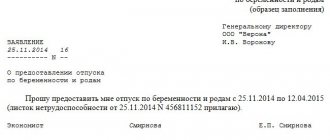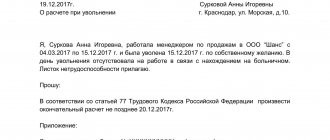Benefit amount and payment period
Severance pay is a lump sum payment upon dismissal and is issued or transferred to an employee of the company regardless of the payment of remaining earnings and compensation for unused vacation. The benefit is paid according to certain rules, administrative acts and dismissal orders with corresponding payments are drawn up on the basis of ordinary personnel forms and their unified forms. The following must be indicated:
- reasons and grounds for making a decision;
- amount of benefits and other compensation.
Also necessary in the document is the signature of the employee, confirming that he has read the document.
Compensation upon dismissal, as well as the grounds for its provision, are provided for in labor legislation and regulations or in a collective and labor agreement. The legislation provides for different amounts of monetary compensation - from two weeks' average earnings or more. It depends on the reason for stopping work.
You need to pay taxes and insurance premiums on your severance pay! Find out for free in ConsultantPlus how to do this correctly.
Payment amount
The size of payments, or rather the compensation included in them, mainly depends on several factors.
These can include:
- date of dismissal of the employee;
- salary amount;
- time elapsed since the last salary;
- time elapsed since last vacation.
All compensation is calculated using special formulas indicated below. In addition, severance pay is included in the amount of payments, if necessary.
How to calculate
If you can still sort out the calculation of wages, then compensation for unused vacation should be given more attention.
The basic formula for calculating compensation upon dismissal is the employee’s average daily salary multiplied by the number of vacation days.
To calculate, you first need to find the average daily salary (hereinafter M) and the number of days of unused vacation.
To calculate “M” you will need to find out the employee’s total income that he received during the calendar year before his dismissal. Once found, it must be divided by 12 (the number of months in a year) and 29.3 (the average number of days in a month). As a result, the average daily salary can be determined.
Now you need to calculate how many days the proposed vacation should last:
- To do this, it is worth calculating the number of months that have been worked since the end of the last vacation.
- The resulting number is multiplied by a factor of 2.33 and rounded to the nearest whole number.
It is worth clarifying that this formula is only effective for those organizations that provide employees with 28 days of vacation. The rest need to turn to the labor inspectorate for help.
To calculate it, you need to know the refinancing rate from the Central Bank (C), as well as the amount of debt (S) and the number of days that have passed since the end of the day of dismissal (D).
After all the circumstances have been clarified, it is enough to substitute the values into the formula: “C/100% × 1/300 × S × D.”
An example of calculating severance pay and compensation for unused vacation upon dismissal
Petrova resigned on July 20, 2014 due to changes in working conditions. Severance pay should be calculated in a single amount (05.2014 and 06.2014 are taken into account). Petrova received a salary of 10 thousand rubles. She also received about 4 thousand rubles in hospital benefits (not taken into account when assigning severance pay).
Petrova did not have time to rest during her 28-day vacation.
- Let's calculate the average daily income (for the above 2 months, 33 days were worked):
10,000: 33 = 303 rubles.
- Salary calculation based on average monthly number of days (20):
303 x 20 = 6060 rubles - this will be the amount of severance pay.
- Amount of compensation for unprovided leave:
303 rubles x 28 days = 8484 rubles.
Is it subject to personal income tax?
For working employees, income and compensation for unused vacations are taxed, as well as severance pay amounts, the amount of which exceeds the established ones several times. Those who quit are exempt from taxes.
Taxation does not provide for personal income tax deductions from income that relate to payments to employees in the event of their dismissal.
This is also important to know:
Dismissal of an employee of pre-retirement age
The same applies to payments for unused vacations, as well as severance pay. But if the latter was not transferred and was included in the company’s income, then the employer is obliged to pay NNP. Vacation compensation upon dismissal in 2021 is mandatory.
Who will be paid for 14 days
A dismissal payment in the amount of two weeks' average earnings is due in the following cases:
- Upon termination of an employment contract for medical reasons. If an employee is recognized as completely disabled or for any reason does not want to transfer to a new workplace, then he is entitled to severance pay upon dismissal for health reasons, two weeks’ pay and wages for the time actually worked. It is important to note that if an employee quits due to health reasons, but at his own request, then compensation is not paid.
- The legislator established severance pay upon dismissal from the army, which is compensation in the amount of two weeks' earnings and is paid upon conscription into the army or assignment to an alternative service replacing it.
- In case of dismissal upon reinstatement of the employee in service by a court decision.
- If an employee refuses to take a position when the company moves to another city or region.
- If you disagree with changes to the terms of the employment contract in the manner prescribed by Art. 74 Labor Code of the Russian Federation.
Dismissal of an employee who has worked for 2 weeks, 1 month, 5 months, 6 months, 11 months
There are situations when an employee has to be fired at his own request or on the initiative of the employer, when he has worked very little, or has worked for less than a full month, or has not stayed at the enterprise until the end of the working year.
In such cases, the employer must competently carry out the dismissal procedure, otherwise the employee’s rights will not be respected. Most often, the dismissal of an employee who has worked only 2 weeks occurs:
- on their own initiative,
- based on the results of the probationary period (option for those dismissed after 2 weeks and 1 month of work).
This is also important to know:
Unlawful dismissal: consequences for the employer
If it was decided to formalize the dismissal of an employee as having failed the test, you need to remember that for this a probationary period had to be assigned, and it could last no more than a month. Labor legislation does not establish an employer’s obligation to prescribe tests, and therefore, if the company’s policy does not provide for any testing of a candidate’s abilities for a job, then it will be possible to fire him only for absenteeism and violations, or at will.
If a decision is made to formalize the dismissal as a resignation of one’s own free will, the employee is obliged to notify about this 2 weeks in advance, which will subsequently have to be worked out if the employer requires it (if desired, the parties can agree on dismissal on any day without working out the required period). It happens that work is not possible due to the employee moving to another region, pregnancy, etc.
Payments upon dismissal at one's own request:
- issue wages for the time actually spent at work;
- make calculations and accrue compensation for vacation that could have been used, but which never came to pass (on average, for a month of work, the right to 2 days of rest arises, therefore, for 2 weeks of work and for 1 month of work, 1-2 days should be compensated non-vacation).
Dismissal after 5, 6 and 11 months of work can be motivated as follows:
- The employee himself wished to leave the workplace.
- The duration of the urgent contact has expired.
- An employee is transferred to a new position in another company.
- Staff reduction.
- Liquidation of the enterprise.
- Allowing employees to regularly violate labor discipline.
Even when an employee has not worked for a full six months or a year, he will be entitled to compensation for unused rest days. And if there has been a reduction in staff, or the employee’s departure from work was initiated by the employer for another reason, the employee is entitled to other types of compensation for early termination of employment.
Salary for less than a month of performance of official duties is calculated:
- By the nominal number of days in a month (the average number of days in a month is determined by regulatory documents, in 2021 it is 29.4 days):
Salary = full salary: 29.4 x ChOD, where
- Salary - salary calculated based on the nominal number of days,
- FZP - actually assigned salary,
- CHOD - number of days worked.
- Based on the actual number of days in a month:
ZP = FZP: KDM x CHOD, where
- Salary - salary calculated based on the actual number of days in the month,
- FZP - actual salary of the employee,
- KDM - number of days in a month,
- CHOD - number of days worked.
Additionally, holidays, weekends, days of absence are taken into account with the same salary.
Who will be paid the monthly income?
Compensation in the form of one month's earnings is paid:
- in case of staff reduction or liquidation of an enterprise (clause 1, 2, part 1, article 81 of the Labor Code of the Russian Federation);
- upon cancellation of employment contracts executed with violations (clause 11, part 1, article 77 of the Labor Code of the Russian Federation).
In case of downsizing or liquidation of an enterprise, payment is made along with the settlement and in the first month after the official severance of the employment relationship. But such payments are not available to seasonal workers, conscripts, and part-time workers.
Payment of severance pay upon dismissal due to liquidation of the organization
According to paragraph 3 of Art. 62 of the Civil Code, the powers to make a decision on liquidation and determine its terms are vested in the founders of a legal entity. For more information about what other actions are taken when performing this procedure, read the article on the website Step-by-step instructions for liquidating an LLC. This event, as well as the termination of the work of an individual entrepreneur (IP), is the basis for the dismissal of employees at the initiative of the employer under clause 1 of Part 1 of Art. 81 Labor Code of the Russian Federation.
To pay severance pay, you need to prepare the following documents:
- Written warning to employees no later than 2 months in advance about the upcoming dismissal due to liquidation.
- Written consent of the employee if the administration decided to dismiss at an earlier date. In such a situation, additional compensation is payable in the amount of earnings for the remainder of the warning period (the calculation is similar to the definition of severance pay, Article 180 of the Labor Code of the Russian Federation).
- An order of dismissal, which the employee must be familiarized with against signature.
- Note-calculation according to f. T-61 (more about it below), which is the basis for payments, is accompanied by an accountant’s certificate.
- The primary cash document for cash payments or a payment document confirming the execution of a non-cash transfer to the employee’s account.
Read more about the procedure for dismissal due to liquidation in the article on the website Dismissal of an employee due to liquidation of an organization. The same procedure applies to members of the liquidation commission.
When a larger amount is due
If the employee has not found a new job
For the second month, benefits are paid if the former employee was unable to find a job within 60 days (in case of staff reduction or company liquidation). In some cases, payment for 3 or even 6 months is possible if the employee applied to the employment center (two weeks and 30 days, respectively), but there was no vacancy and he did not find a job (Articles 178 and 318 of the Labor Code of the Russian Federation).
To confirm that the former employee has not taken a new job, he brings the relevant documents to the former employer. Their list depends on the month for which benefits are paid after dismissal.
| Period from the date of dismissal | Amount of payment and list of documents to be presented to the former employer |
| After the second month. After the second and third months - for workers of the Far North and equivalent territories | Average monthly earnings. Documentation:
|
| After the third month. After the fourth, fifth and sixth months - for workers of the Far North and equivalent territories | Average monthly earnings. Documentation:
|
If a citizen gets a job at this time, he will be paid only for the time he was registered with the employment service. In this case, instead of the original work book, they bring a copy of it, certified at the new place of work.
Also, the Labor Code (Articles 181, 278, 279) provides for special payments upon dismissal of the enterprise’s managers, their deputies and the chief accountant at their own request in 2020. In this case, for the period of employment, compensation is three monthly earnings.
Types of compensation for dismissed employees
What is paid upon dismissal?
- Compensation for dismissal of an employee due to poor health.
- Payments upon dismissal at the initiative of the employee.
- Payments upon dismissal by agreement of the parties.
- Payments upon dismissal of an employee due to staff reduction.
For any reason for staff leaving the enterprise, the employer must make payments for annual leave that the workers did not have time to take. When leaving work occurred on the initiative of the authorities, those dismissed are also entitled to severance pay (in addition to payment for the time actually spent at the workplace while performing official duties).
Free legal consultation We will answer your question in 5 minutes!
Ask a Question
Free legal consultation
We will answer your question in 5 minutes!
Ask a Question
Compensation for early termination of an employment contract
Dismissal in case of early termination of an employment contract must be preceded by notification by the employer to the employee 2 months before the date of his actual departure from work. The employer does not have the right to force an employee to write a letter of resignation of his own free will, since this is beneficial exclusively to the employer, who will not have to pay his employee severance pay.
When reducing staff, the law generally prohibits specifying the reason for dismissal as “personal desire of the employee,” since two grounds for leaving work cannot arise simultaneously. In addition, an entry in the work book upon dismissal due to staff reduction is more beneficial for the worker both in terms of finding a new job and in terms of obtaining various benefits.
This is also important to know:
Dismissal due to the death of an employee: step-by-step instructions for registration
The procedure for such dismissal is as follows:
- The employee receives a notification and agrees to it.
- The employer instructs the accounting department to pay the employee for the amount of compensation for unprovided vacation and severance pay.
- The employee receives a compensation payment for early termination of his employment contract.
Additionally, compensation is assigned for the period remaining until the end of the notice period. In total, the fired person will receive his due salary with all allowances, compensation for rest that was not given, severance pay and compensation salary for the time that he could still work before the dismissal, but agreed not to work.
The purpose of imposing an obligation by law on an employer to pay severance pay is to provide a means of livelihood for an employee who, through no fault or unwillingness, has lost a source of income while he is looking for a new employer.
It is worth keeping in mind that any misconduct in the workplace that would not have been taken into account before, before dismissal, can serve as a reason for manipulation on the part of the employer in order to force the employee to resign of his own free will. At such a time, you should not allow lateness or other, even minor, disciplinary violations.
Compensation for vacation that the employee did not have time to take
For whatever reason, an employee leaves work, among the obligatory payments for him will be compensation for annual leave not provided before the date of dismissal. Moreover, if he had the right to vacation twice, but did not go on vacation for two years in a row, he will receive double compensation.
However, working for 2 years in a row without rest is illegal, and therefore the employer must give an explanation about this, except in cases where the employee has done something wrong. The procedure is this because compensation for unused vacation is not paid if the employee is fired for serious violations. The day of actual departure from the enterprise will be the last day of rest, and before that the employee will already be given all the compensation due to him for unused vacations.
Employee compensation for staff reductions
The dismissal of employees when reducing the company's staff is recognized by law as independent of the wishes of management and subordinates. Extra-budgetary funds are involved in the implementation of social programs aimed at providing for citizens who have lost their jobs through no fault or initiative.
Dismissed employees receive wages with the allowances and bonuses they are entitled to for the time actually spent at work, compensation for annual rest not provided (if any), severance pay, which is certainly paid in two cases:
- upon closure of the enterprise,
- when staffing is reduced.
The average salary is retained by a dismissed employee only until (but not more than 3 months, and only after such a decision is made by the Employment Service) he signs a contract with a new employer. And if we are talking about a part-time worker who still has a second job, then he is not entitled to severance pay at all.
If there is no part-time job, the dismissed employee contacts the Employment Service within 14 days and leaves an application to find a new job. And in the event that the Employment Center does not find a suitable position at another enterprise, it will receive from the former employer the amount of its average earnings for 3 months instead of the standard two.
Compensation for police officers upon dismissal
Police officers are entitled to full compensation for each vacation not used on time until January 1 of the year in which the dismissal took place (the reason does not matter). Compensation amounts for rest that the police officer did not take during the year of dismissal will be paid:
- upon length of service at which the right to pension payments arises, upon reaching the age limit, upon dismissal due to staff reduction or deterioration of health (for annual leave in full, and for other types of rest - in proportion to the length of service in the year of departure from service in the amount of 1/12 of the vacation for 1 full month of work);
- for all other reasons (for each entitled type of rest in the amount of 1/12 of the duration of leave for 1 full month of service based on the average salary).
This is also important to know:
In what cases is the day of dismissal considered a working day?
When a police officer leaves service, he is entitled to:
- Salary for the entire period of service.
- Quarterly bonus calculated based on actual time served.
- Compensation equal in value to at least two salaries for the year (if it was not paid in the relevant year).
- A one-time financial incentive based on the results of 12 months is proportional to the time actually spent in service.
- Compensation for vacation not provided before dismissal.
- One-time benefit in the amount of:
- 5 average monthly salaries (dismissal due to age, health reasons, staff reduction, illness, after 10 years of service),
- 10 average monthly salaries (with 10-14 years of service),
- 15 average monthly salaries (with 15-20 years of service),
- 20 average monthly wages (with more than 20 years of service),
- 40% of the transferred amounts (if dismissed for other reasons),
- the transferred amounts + 2 salaries (if the policeman was awarded an order during his service or was awarded an honorary title).
The salary is the one that was assigned at the time of dismissal. Years of service are not rounded to full years. If dismissal occurs upon re-employment, payments are calculated with the offset of previously paid amounts for length of service. If the total length of service was less than 15 years, and the policeman was dismissed without the right to a pension, his salary is retained for 12 months after leaving service (annual indexation is taken into account).
When retiring
When retiring, an employee can receive not only compensation for vacations and wages.
He may also be entitled to additional payments. But only if the collective agreement specifies special conditions under which accruals are made to employees leaving due to retirement age. Sick leave after dismissal in 2021, according to the Labor Code, must be paid by the employer within a month.
Sick leave pay after dismissal
A former employee has the right to claim sick leave payment through the company from which he was dismissed, provided that no more than a month has passed from the date of registration of the event. Only those citizens who have not been employed since the termination of their employment contract should contact the head of a business entity. The certificate of incapacity for work must be presented no later than 6 months from the date of termination of the employment relationship. When calculating the amount of payment, length of service is not taken into account, and when determining its size, the salary is adjusted to 60 percent. If the sick leave was issued to a close relative, then it is not payable.
Dismissal during illness
In case of serious illness, the employee may be on sick leave for a long time. During this period, he has the right to resign for his own reasons or by agreement of the parties, due to the initiative of the employer due to the need to perform duties by a constantly absent person and assign them to a new employee.
The procedure for dismissing a person on sick leave is no different from terminating a contract with a working employee. He must notify the employer of his desire, and after two weeks receive a payment. For a dismissed employee with an open sick leave certificate, the payment amount can be calculated only after receiving a closed sick leave certificate issued by a medical institution. Payments are made on the nearest payday.
Dismissal of a manager or chief accountant
It happens that managers or chief accountants quit. Payments will be accrued in the following cases:
- they were removed from office by the founders without any guilt;
- The new owner of the business decided to fire them.
There are several situations when a change of ownership of a company occurs:
- privatization of state and municipal property (sale or provision into private ownership);
- retransfer of property belonging to the organization in favor of the state;
- sale of the enterprise as a whole complex of property.
A change in the composition of the company's participants (inclusion of new participants or withdrawal, exclusion of old ones, including a complete change in composition) does not constitute a change of owner.
The employer in accordance with Art. 278 of the Labor Code of the Russian Federation pays the manager money in the amount established by the employment agreement, but not less than three times the average monthly salary.
But there are also nuances in the payment of benefits upon dismissal of managers, their deputies and the chief accountant - amounts of money are not paid if:
- there are illegal actions on their account;
- they made decisions that negatively affected the financial position of the organization.
When they will only pay if agreed upon with the employer
Upon resignation of one's own free will
If the contract is terminated at the request of the employee, then no incentive or compensation payments are provided for by law, that is, severance pay is not provided for voluntary dismissal. But if management wants to reward an employee for long and fruitful work, they will award a bonus on their own initiative; such cases are known.
By agreement of the parties
Typically, dismissal by agreement occurs on an individual basis. The amount of the fee is not established, so payment is made by mutual agreement of the parties. The problem of the amount of payment, how to calculate severance pay upon dismissal by agreement of the parties, is solved within the framework of individual agreements.
But the salary, which was not paid to the employee for the period worked, is issued without fail on the last day of work.
Upon retirement
Labor legislation does not provide for severance pay upon retirement, but in accordance with Part 4 of Art. 178 of the Labor Code of the Russian Federation, similar bonuses are allowed to be prescribed in the employment contract or they may be provided for by internal regulations of the organization itself. Such payments are provided at the request of the employer and are not regulated by law. The organization has the right to establish any number of financial assistance measures without restrictions. This type of help is, rather, gratitude for the work.
Other payments upon dismissal
The benefit may also be paid in other cases of dismissal provided for:
- Labor Code of the Russian Federation. This is compensation to the manager and chief accountant, as well as their deputies when the owner of the organization changes by decision of the founder - in the amount of 3 times earnings (Articles 181, 279 of the Labor Code of the Russian Federation).
- Other laws. For example, according to paragraph 3 of Art. 15 of the Law of the Russian Federation “On the status of judges in the Russian Federation” dated June 26, 1992 No. 3132-I - no less than 6 times the monthly remuneration for the position being left.
- An individual or collective labor contract, incl. A voluntary dismissal benefit may be provided. Such conditions can be set out in an additional agreement to the employment contract (Article 57 of the Labor Code of the Russian Federation, letter of the Ministry of Finance of the Russian Federation dated March 31, 2011 No. 03-03-06/1/188), but not in the dismissal agreement, which, even if it severance pay is provided upon dismissal by agreement, is not:
- an additional agreement and cannot contain an obligation to pay benefits (see the appeal ruling of the Investigative Committee for civil cases of the Altai Regional Court dated April 4, 2017 No. 33-3807/2017);
- management decision on the payment of severance pay stipulated by the employment contract (determination of the Investigative Committee for Civil Cases of the Armed Forces of the Russian Federation dated August 10, 2015 No. 36-KG15-5).
The severance pay provided for in clause 1 of the order of the Minister of Defense of the Russian Federation “On payment to the wives of military personnel ...” dated July 11, 2002 No. 265, paid at the expense of the budget of the Russian Federation, in the amount of 2 months’ earnings when the spouse moves to work in another locality, is not considered severance pay, since it not paid by the employer.
Other cases
If an employee was illegally fired and he is reinstated to his previous place of work, then he is entitled to severance pay upon reinstatement at work for the entire period of the employee’s absence (forced absenteeism). The organization is obliged to calculate the average salary (if it was an illegal dismissal) or compensate the difference in wages (if it was an illegal transfer).
Since an individual entrepreneur is not a company or a legal entity, a number of labor laws are not applicable to it. According to the decision of the Supreme Court No. 74-KG16-23 dated 09/05/2016, employees working for individual entrepreneurs count on benefits, but they are not always paid:
- upon liquidation of a business, termination of activities as an individual entrepreneur;
- when staffing is reduced.
However, an individual entrepreneur is obliged to notify the employee of the upcoming dismissal and pay him the amounts due if such conditions and guarantees are included in the employment contract.
The law enforcer proceeds from the fact that this employer is an individual, and severance pay for cumulative accounting of working hours is paid in the same way as for any other accounting.
Table of benefit amounts depending on the circumstances of dismissal
| Grounds for dismissal | Benefit amount |
| Liquidation of a company | In the amount of average monthly earnings for all categories of workers, with the exception of those specified in Art. 178 Labor Code of the Russian Federation:
|
| Reduction in headcount or staff | __//__ |
| Refusal to transfer for medical reasons | Average earnings for two weeks |
| Conscription into the army or alternative service | __//___ |
| Due to the reinstatement of an employee who previously performed work, by a court decision or labor inspectorate | __//___ |
| Refusal to transfer together with the organization to another location | __//___ |
| Recognition based on a medical report as completely incapable of performing relevant duties | __//___ |
| Refusal to work under new conditions | __//__ |
| Violation of the rules for concluding an employment contract established by law, which occurred through no fault of the employee, if such a violation precludes transfer or continuation of activity | Average monthly earnings |
How much is paid?
The amount of severance pay depends on the reasons for which the employee was dismissed from the organization. Pay in the amount:
- average monthly earnings;
- two weeks' earnings.
Average monthly earnings are paid upon liquidation of an organization or reduction in headcount or staff. In addition, the average monthly salary for the period of employment is paid, but not more than two months in total. But if an employee registers with the employment service within two weeks after termination of the contract, but does not find a job, then, by decision of this body, he will be paid wages for the third month.
Severance pay in the amount of two weeks' salary is due when the employee:
- refused to be transferred to another job for medical reasons;
- declared incompetent in accordance with a medical report, that is, severance pay is paid upon dismissal due to disability to the first group, when the employee is no longer able to work;
- called up for military (alternative civilian) service;
- the former employee who previously held this position was reinstated;
- refused to move when the employer moves to another area;
- refused to continue working due to changes in certain terms of the employment contract;
- performed seasonal work (during the liquidation of an organization or reduction in numbers or staff).
A monthly salary is paid in the form of severance pay when the rules for concluding a contract are violated due to the fault of the employer. The employee is unable to continue working and cannot be transferred to another position.
Three times the average monthly salary is paid to the head of the organization, his deputies and chief accountants when:
- change of owner of the organization’s property (Article 181 of the Labor Code);
- decision by an authorized body of a legal entity or the owner (or his authorized person) to terminate the contract in the absence of guilty actions (Article 279 of the Labor Code).
Article 349.3 of the Labor Code clarifies that compensation for these categories of workers is limited: no more than three times the average monthly salary.
The amount of payments upon dismissal is established by the Labor Code, but the employer has the right to prescribe additional compensation in local acts (collective and labor agreements).
The procedure for calculating the payment and the formula for calculation
The calculation formula looks like this:
Severance pay = average daily wage × number of working days in the month following the month of dismissal.
To calculate severance pay, you need to determine the following values:
- billing period;
- the number of days that the employee actually worked;
- total salary;
- the number of days recognized as workers during the period for which benefits are paid.
Calculated payment period
The 12 calendar months preceding the month in which the employee is laid off are taken.
Actual days worked
All working days when the employee worked are taken into account.
The time spent on annual leave and sick leave is not taken into account.
Examples of calculations
Let us show with examples how benefits are calculated.
Example 1.
Svetlyachkov I.S. worked at Vesna LLC. On 10/16/2020 he was fired due to the liquidation of the organization. Svetlyachkov’s monthly salary was 23,000 rubles, and his vacation was used in full. Upon termination of the contract, Svetlyachkov must be paid:
- wages for days worked;
- severance pay.
In October 2021, there are 22 working days, of which the employee worked 10. His earnings will be:
23,000 rub. / 22 × 10 = 10,454.50 rubles.
To calculate severance pay, the average earnings are used. Over the past 12 months, Svetlyachkov worked 260 days.
23,000 × 12 / 260 = 1061.54 rubles.
There are 20 working days in November, which means the severance pay will be:
1061.54 × 20 = 21,230.80 rubles.
Example 2.
Romashkina Maria Petrovna was fired on September 31, 2020 due to staff reduction and immediately registered with the employment service. Upon dismissal, she was given a salary for September in the amount of 30,000 rubles. The vacation was fully used, therefore, there was no compensation for it.
During the previous billing year, she worked 249 days. Let's calculate monthly earnings:
30,000 × 12 / 249 = 1445.78 rubles.
In September there were 22 working days, therefore, Maria Petrovna received severance pay in the amount of:
1445.78 × 22 = 31,807.16 rubles.
But this month she was unable to find a job. Due to the fact that she contacted the employment service on time, she is entitled to benefits for another 30 days. There are 22 working days in October, therefore, Maria Petrovna will receive benefits in the amount of:
1445.78 × 22 = 31,807.16 rubles.
She will no longer be paid.
How to correctly calculate severance pay
Typically, an employee’s average earnings for calculating severance pay are calculated based on data for the last year. But it is also allowed, for example, for the last three months or six months.
If the date of dismissal falls on the last day of the calendar month, it is included in the calculation. Otherwise, the countdown starts from the previous month. For example, if an employee is planned to be fired in mid-February 2021, the payroll period ends in January of the same year.
Next, the following algorithm is applied:
- All salaries accrued to the dismissed person for the payroll period are summed up before taxes and various deductions, such as alimony, are deducted.
- Based on time sheets, all days worked by the employee during this period are counted.
- The total salary for the billing period is divided by the number of days worked.
- The resulting average daily earnings are multiplied by the number of working days in the next month. If we fire an employee in February, then the working days of March are taken into account according to the organization’s schedule. The result will be the benefit due to the employee.
Now let’s calculate using this example: we base the benefit on earnings for the last three months, during this time 72 were worked, the employee’s earnings in two of the months taken into account amounted to 50 thousand and in one 75 thousand rubles, in the next month 24 working days.
So:
- 50000+50000+75000=175000.
- 175000/72=2430.5 per day.
- 2430.5x24=58332 rubles - the amount of severance pay.
When earnings are fundamentally affected by the number of hours worked, it is not the average daily income that is calculated, as in the case considered, but the average hourly income.
Severance pay is calculated based on the employee’s average daily or average hourly earnings
The algorithm of actions takes the following form:
- We sum up all salaries for the billing period.
- We sum up all the hours worked during this period. At what rate they were paid, whether there was overtime, work on weekends, etc., does not matter. The hours reflected in the time sheet are simply summed up.
- We divide the employee's total salary by the total number of hours, obtaining his average salary per hour of work.
- We calculate the total number of working hours in the next month. To do this, we multiply the number of working days according to the schedule by the standard duration of the working day. In our case, this is eight hours, but there are also organizations with a different working hours.
- We multiply the average hourly earnings by the number of standard working hours according to the schedule for the next month. And as a result, we get the amount of the benefit.
Let's consider the same introductory one, but add a new parameter - for all three months that formed the basis for the calculation, the working day of the dismissed person was the standard eight hours. It turns out that he worked 576 hours.
Let's use the algorithm:
- 50000+50000+75000=175000.
- 175000/576=303.82 rubles per hour.
- 24x8=192 standard working hours next month.
- 303.82x192=58333.44 rubles - the amount of severance pay.
In the example considered, the size of the benefit when calculated based on average daily and average hourly earnings turned out to be approximately the same. But when the employee’s income includes, for example, overtime, the cost of an hour and, accordingly, the benefits for the hourly option are lower.
In order not to be unfounded, I will give the following example. All other things being equal, the employee worked overtime during the month for which he earned 75 thousand rubles, and his working day was 10 hours. This means that I worked 24x10 = 240 hours during this month, while the other two worked 24x8 = 192 hours.
Let's use the algorithm:
Our total earnings for three months remain unchanged - 175 thousand rubles.
But we count the hours again: 192+192+240=624 hours.
175000x624=280.45 rubles per hour.
Since we take into account only the standard hours of the next month, and our number is 24x8 = 192, we multiply the resulting average salary per hour by this figure: 280.45x280.45 = 53836.8.










